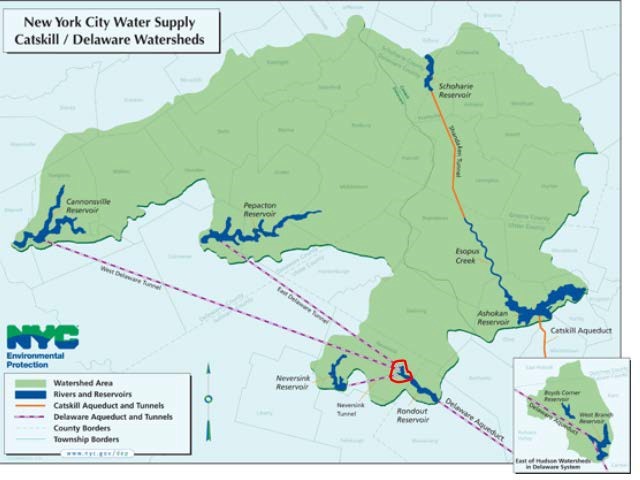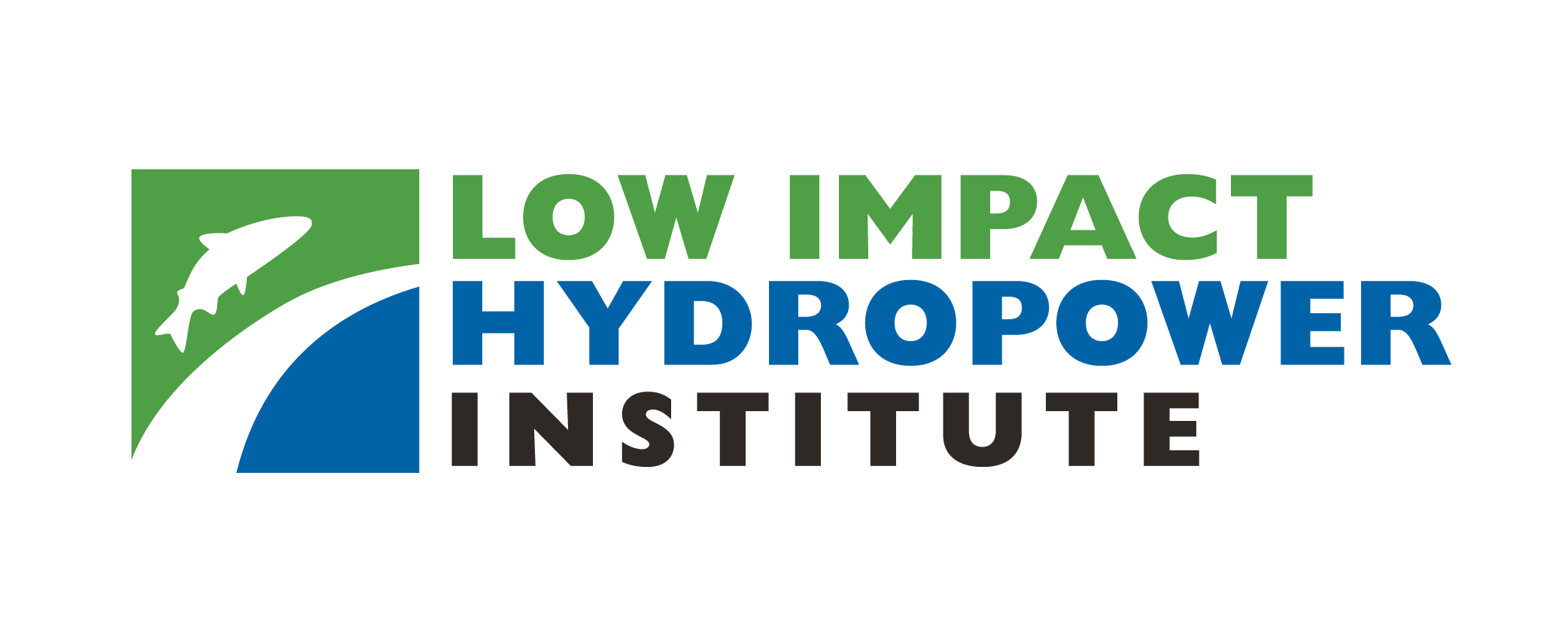Certificado LIHI #151 – Proyecto del Túnel de West Delaware, Nueva York

| Nombre del proyecto | Túnel de West Delaware |
| Certificado LIHI No. |
151 |
| Plazo del certificado LIHI |
29 de marzo de 2019 – 28 de marzo de 2034 |
| Dueño | West Delaware Hydropower Associates, LP, una subsidiaria de Brookfield Renewable Energy Group |
| Estado | Nueva York |
| Ubicación | Acueducto del oeste de Delaware |
| Capacidad instalada | 7,5 MW |
| Generación media anual | 26.400 MWh |
| Tipo de instalación | Conducto |
| Comisión Federal de Comercio No. | P-9159 exento 1986 |
El Proyecto del Túnel de West Delaware se ubica cerca de Grahamsville, en el condado de Sullivan, Nueva York, en terrenos propiedad del Departamento de Protección Ambiental de la Ciudad de Nueva York (NYCDEP), como parte de su Acueducto de West Delaware, que abastece de agua potable a la ciudad de Nueva York. El proyecto se ubica en el acueducto entre Rondout. Depósito y el embalse de Cannonsville. El proyecto se construyó en 1987, varias décadas después de la construcción de los dos embalses en 1950 y 1964, respectivamente.
El proyecto incluye un puente de 60 pies de largo y 66 pulgadas de diámetro. compuerta y un central eléctricaEl propietario tiene una servidumbre de uso para la propiedad. La casa de máquinas contiene una vertical Turbina FrancisGenerador con una capacidad de 7,5 MW. El agua se desvía del Acueducto de West Delaware a la tubería forzada subterránea, que la lleva a la turbina de la central eléctrica. El agua se descarga en un... piscina tranquilizadora (utilizado para reducir la velocidad del agua) que a su vez descarga en el embalse de Rondout.
El proyecto opera como una instalación de conducción. Semanalmente, el NYCDEP envía una asignación de agua según las necesidades de suministro de agua de la ciudad de Nueva York. El sistema del NYCDEP determina la asignación semanal de agua basándose en diversos factores, como los niveles de los embalses, las previsiones de afluencia, la climatología y la calidad del agua. Si el NYCDEP asigna una asignación específica, el propietario del proyecto determinará el caudal y el cronograma para entregar la asignación solicitada durante el período especificado. Normalmente, el proyecto operará su turbina con la máxima eficiencia para maximizar la energía. alcanzando su punto máximo cronograma.
Las aguas dentro del alcance del proyecto están clasificadas como agua potable de Clase AA. Los embalses asociados presentan niveles de mercurio reducidos por deposición atmosférica, y el embalse de Cannonsville está clasificado por fósforo proveniente de fuentes agrícolas y municipales. Al ser una instalación de conducción, el proyecto no afecta la calidad del agua.
El proyecto no crea ninguna barrera para paso de peces Tampoco se prevé que los peces migratorios se vean afectados por el agua que fluye por el acueducto. Ambos embalses se abastecen anualmente con truchas marrones, de lago y arcoíris, y se pueden encontrar poblaciones naturales de sábalo y eperlano en el embalse de Rondout gracias a su afluente (arroyo Rondout).
La central eléctrica se encuentra dentro de una propiedad cercada con una superficie aproximada de 4000 yardas cuadradas. No se encuentran terrenos de valor ecológico significativo en el área del proyecto debido a su naturaleza artificial.
Entre las especies amenazadas y en peligro de extinción que podrían encontrarse en las inmediaciones del proyecto se encuentra el águila calva. Se ha observado un nido de águila calva a unos 152 metros del límite del sitio. La única preocupación identificada fue el diseño de las líneas de transmisión para evitar los riesgos de electrocución asociados con el proyecto. El Servicio de Pesca y Vida Silvestre de EE. UU. planteó esta preocupación, pero las líneas de transmisión no son propiedad del proyecto.
El propietario del proyecto consultó con la División de Preservación Histórica del Estado de Nueva York, que concluyó que ninguna propiedad histórica se ve afectada por las operaciones del proyecto.
La central eléctrica es una zona segura y vallada, sin posibilidad de acceso público. La recreación en el cercano embalse Rondout está estrictamente controlada y gestionada por el Departamento de Protección Ambiental de Nueva York (NYCDEP), ya que se utiliza para el suministro de agua potable.
Estado de cumplimiento
En el Certificado actual no existen condiciones específicas para ninguna instalación.
2025: No se identificaron cambios materiales ni problemas de cumplimiento. El proyecto sigue cumpliendo con los requisitos según la revisión anual.
2024: No se identificaron cambios materiales ni problemas de cumplimiento. El proyecto sigue cumpliendo con los requisitos según la revisión anual.
2023: No se identificaron cambios materiales ni problemas de cumplimiento. El proyecto sigue cumpliendo con los requisitos según la revisión anual.
2022: No se identificaron cambios materiales ni problemas de cumplimiento. El proyecto sigue cumpliendo con los requisitos según la revisión anual.
2021: No se informaron cambios ni problemas de cumplimiento. El proyecto sigue cumpliendo con los requisitos según la revisión anual.
2020: No se informaron cambios ni problemas de cumplimiento. El proyecto sigue cumpliendo con los requisitos según la revisión anual.
2019: La presentación de informes anuales para el Certificado actual aún no ha entrado en vigor.
Historial de certificaciones
1 de enero de 2022: El plazo del Certificado LIHI se ha extendido de acuerdo con la Revisión 2.05 del Manual de Certificación LIHI 2.ª Edición emitido el 1 de enero de 2022. Consulte la tabla de instalaciones anterior para conocer el nuevo plazo.
16 de julio de 2019: La decisión de certificar el Proyecto Hidroeléctrico del Túnel de West Delaware es definitiva. No se recibieron apelaciones durante el período de apelación, que cerró el 13 de julio de 2019. El nuevo plazo de certificación del Proyecto es del 29 de marzo de 2019 al 28 de marzo de 2029.
12 de junio de 2019: El Instituto de Energía Hidroeléctrica de Bajo Impacto (LIHI) ha aprobado preliminarmente la Certificación de Bajo Impacto para el Proyecto Hidroeléctrico del Túnel West Delaware.
Esta decisión es preliminar y está pendiente del período de apelación de 30 días. Solo aquellos que comentaron sobre la solicitud inicial durante el período de comentarios de 60 días son elegibles para presentar una apelación. Dicha apelación debe incluir una explicación de por qué el Proyecto no cumple con los criterios de LIHI. Las solicitudes de apelación se pueden enviar por correo electrónico a comentarios@lowimpacthydro.org Con el asunto "Proyecto Hidroeléctrico del Túnel de West Delaware", o por correo postal dirigido al Instituto de Energía Hidroeléctrica de Bajo Impacto, 329 Massachusetts Ave, Suite 6, Lexington, MA 02420. Todas las solicitudes se publicarán en el sitio web. El solicitante tendrá la oportunidad de responder, y cualquier respuesta también se publicará. Las solicitudes deben recibirse antes de las 5 p. m., hora del Este, el 13 de julio de 2019. La solicitud completa y el informe de los revisores están disponibles a continuación.
Si no se reciben solicitudes de apelación y la decisión es definitiva, el período de certificación para el Proyecto (pendiente LIHI #151) será del 29 de marzo de 2019 al 28 de marzo de 2029.
2 de abril de 2019:El Instituto de Energía Hidroeléctrica de Bajo Impacto (LIHI) ha recibido una solicitud completa para la Certificación de Bajo Impacto del Proyecto Hidroeléctrico del Túnel de West Delaware. LIHI solicita comentarios públicos sobre esta solicitud. En concreto, nos interesa saber si considera que el Proyecto cumple con los Criterios de Certificación de Bajo Impacto de LIHI, revisados en la 2.ª edición del Manual. Por favor, revise el programa y los criterios en la versión revisada de LIHI. Manual y luego revise los materiales de solicitud del Proyecto a continuación.
Los comentarios que estén directamente relacionados con criterios específicos del LIHI (caudales, calidad del agua, paso de peces, etc.) serán de gran ayuda, pero se tendrán en cuenta todos los comentarios. Los comentarios pueden enviarse al Instituto por correo electrónico a comentarios@lowimpacthydro.org con “Comentarios sobre el Proyecto del Túnel de West Delaware” en la línea de asunto, o por correo dirigido al Low Impact Hydropower Institute, 329 Massachusetts Avenue, Suite 6, Lexington, MA 02420. Los comentarios deben recibirse antes de las 5 p. m., hora del Este, el 1 de junio de 2019. Se considerarán todos los comentarios. Se publicarán en el sitio web y el solicitante tendrá la oportunidad de responder. También se publicarán todas las respuestas.
Archivos de certificación
Certificación 2019
- Informe de revisión de la certificación del túnel de West Delaware 2019
- Solicitud de certificación de West Delaware
- Túnel de West Delaware FERC Exención 1986
